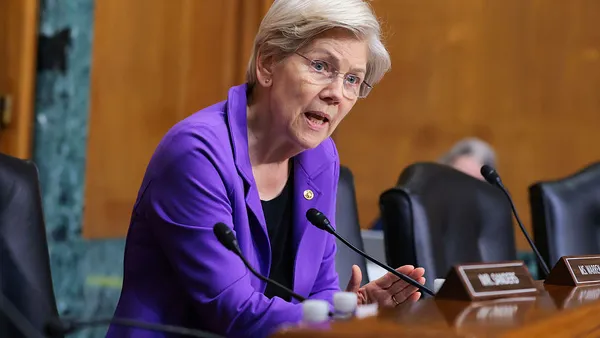Dive Brief:
- Poor CEO succession planning poses “a significant risk” for U.S. banks, according to an analysis this month from leadership advisory firm Russell Reynolds Associates.
- Over the past decade, half of the CEO transitions that occurred at banks with between $20 billion and $250 billion in assets were abrupt or unplanned, Russell Reynolds said in a Nov. 8 report.
- That can have a number of implications for banks, including hurting their stock prices, said Robert Voth, who co-leads Russell Reynolds’ consumer and commercial financial services practice. “When there is not a successful CEO search,” he said, “everyone suffers,” from the company, to customers, to shareholders.
Dive Insight:
In its report, Russell Reynolds also flagged a “potential looming retirement cliff” in the industry. C-suite executives at midsize banks spend an average of 15 years at their companies and have spent an average of six years in their current roles, the firm said.
Current bank CEOs’ average age is 58; nearly one-quarter of bank C-suiters are 65 or older. “This suggests that banks may soon be encountering a leadership vacuum,” necessitating established succession plans, the analysis warned.
When bank CEOs departed abruptly and without any public announcements of long-term succession plans, those bank stock prices took a hit: Their stock fell by an average of 7% the day after the announcement, and finished 8% lower one month later, the analysis said.
“You’d be surprised at the lack of institutional fortitude on the CEO succession. It’s tough to discuss,” Voth said. Yet “the goal is to create a healthy executive ecosystem, in which everyone should understand, nobody stays in their job forever.”
Tenured CEOs that have had a successful run “tend to cloud the urgency and good corporate hygiene” that’s needed for solid succession plans, the analysis noted.
“If a CEO doesn’t want to leave for a decade, OK — but what does that mean for that CEO’s direct reports?” Voth said. “What does that mean for their development programs? And I know you don’t want to leave for 10 years, but in case something happens, what is our contingency plan? And the answer just can’t be, ‘Don’t worry.’”
The Russell Reynolds analysis recommends banks give more attention to three specific aspects: crafting tangible succession plans, improving internal leadership development, and increased involvement of boards.
The “parochial” nature of community and smaller regional banks, whose executives are typically closely linked to their communities, means relationships and reputation are crucial, Voth noted.
The cult of personality tends to be a factor for the smallest and the biggest banks — think Jamie Dimon at JPMorgan Chase.
Large bank boards with seasoned directors are usually on top of succession planning despite this, Voth said. But for small lenders, that cult of personality can sometimes inhibit necessary conversations around succession planning.
When smaller banks search for their next CEOs, candidates who understand the cultural and community needs of the bank are “very, very high” on the requirements list, Voth said.
“So if it’s not someone internal, where do you get them?” he noted. The source environment for a community bank in one corner of the country is likely not a state or region on the opposite coast, for example, he said. Banks in smaller, rural communities can struggle when looking externally, because it may be more difficult to attract talent to a town with several thousand residents than a larger metro area.
As banks begin to consider factors beyond relocation — questions around a candidate’s culture fit, career runway, buyout factors and strategic outlook — the aperture may close quickly, Voth said.
“You might start with 120, but once it goes through the screen, there’s six to eight,” he said. “And that’s the issue.”
A lack of succession planning and the absence of a successor can also lead to firm buyouts. Earlier this year, the National Credit Union Administration issued a rule requiring boards of federally insured credit unions to set up and follow succession planning processes for certain executive roles.
There can be “high costs” when credit unions don’t engage in such planning, NCUA Chairman Todd Harper noted in July, “including the potential for an unanticipated merger of the credit union when key personnel depart.”














